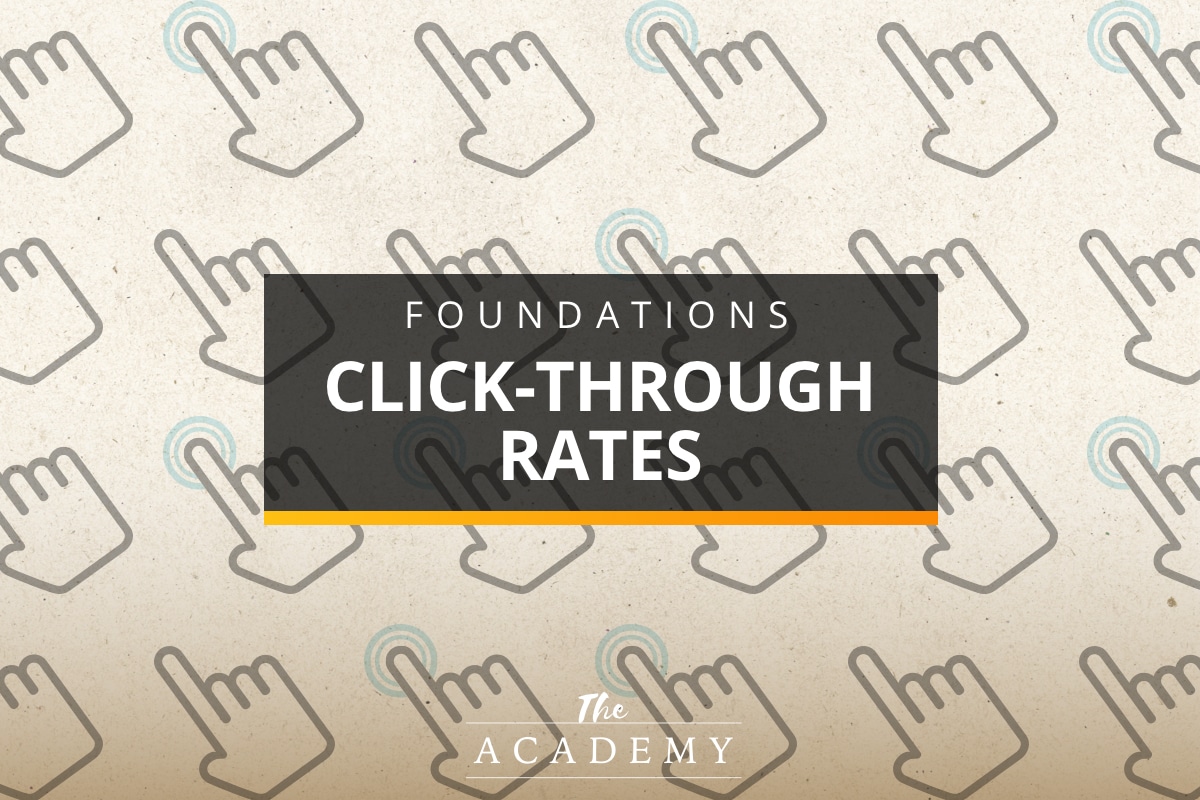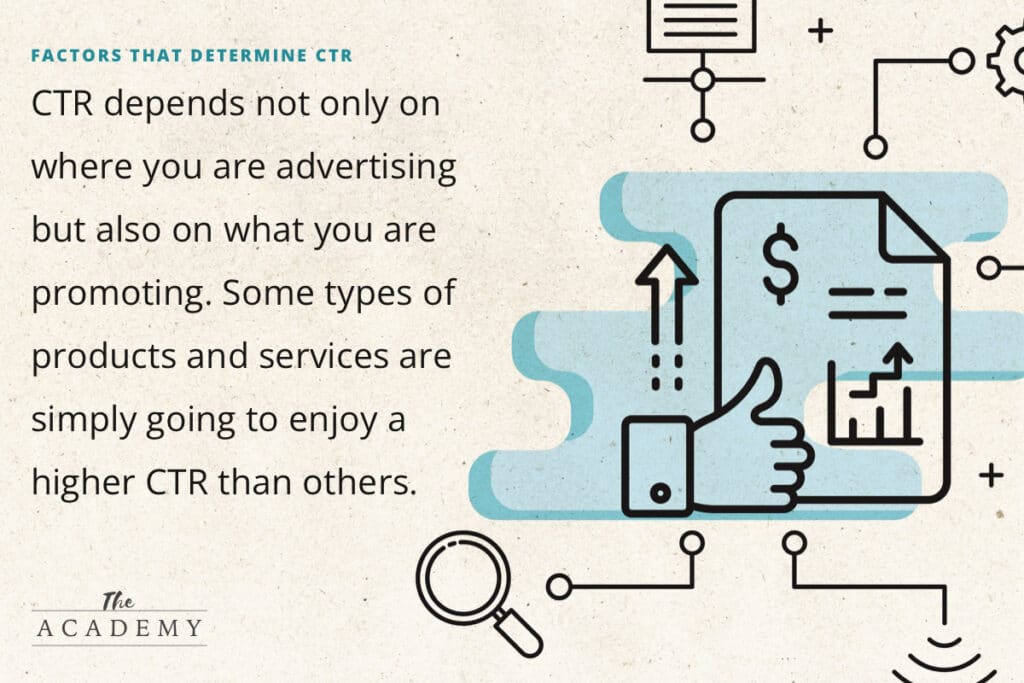
For a digital marketer, click-through rate is one of the fundamental metrics that will be used in many different applications. It’s hard to talk about the performance of any of your marketing initiatives without discussing CTR, so we’d like to use this article to provide a general overview of this topic.
Below, we’ll dive into the matter of how you know what you are looking for in regard to CTR. In other words, what’s a good click-through rate and what numbers should you be hoping to improve? The answer to these questions is context-dependent, so we’ll try to help you gain an overall understanding of how to evaluate the performance of your efforts. Also, with that topic covered, we’ll spend some time talking about how CTRs can be improved through basic improvements in strategy and technique. Let’s get started!
What is a Click-Through Rate?
Quickly, before diving into the meat of the article, let’s talk about what a click-through rate is for anyone who might not be clear on this topic. A click-through rate – usually referred to in shorthand as CTR – is the rate at which people decide to click on something that you present to them. Often, this will be an advertisement in a place like Google or Facebook, but the possibilities are endless.
Don’t be intimidated by the statistical aspect of this area of digital marketing, as the math here is quite simple. Here’s a quick example to show you how CTR works –
- Imagine that you have decided to run some ads on Facebook to promote your business or a specific product.
- You run an ad until it is shown to 1,000 people. In the real world, the numbers will never work out this evenly, but you get the idea.
- After 1,000 views of the ad by your target audience, you see that a total of 10 people have clicked on the ad and been taken to your chosen destination (often a landing page on your site).
- Simply by dividing the number of clicks you collected by the total number of people shown the ad, you can arrive at your CTR. In this case, you’d take 10/1,000 and be left with a CTR of exactly 1%.
If you track your Facebook ad campaign properly, you’ll easily be able to determine that your click-through rate – in this case – is 1%. But what does that mean? Without context, that number is basically meaningless. Only if you know how you are doing compared to average will you be able to make any determinations about whether or not your CTRs are living up to expectations or if they need serious improvement.
Some Helpful Averages
To get you started in the right direction, we can offer some general averages for CTRs that you might expect to find in various places around the web. However, these averages need to come with a big disclaimer – this is just a rough guideline of what you might see. The exact CTR that you can expect is going to depend not only on where you are advertising but also on what you are promoting. Some types of products and services are simply going to enjoy a higher CTR than others, and we’ll talk more about that later.

For now, here are some points that will help you understand how your ad campaigns are performing.
- For starters, let’s talk about Facebook ads. On Facebook, it’s important to remember that you are advertising mostly to a “cold” audience. In other words, you are presenting your ads to people who aren’t particularly excited about seeing them. These are people that you have targeted for one reason or another on the Facebook platform, but they aren’t necessarily looking actively for what you want to sell. As a result, the CTRs on Facebook ads tend to be quite low. If you are getting anywhere up near that 1% rate in our example above, you should consider your ads to be performing pretty well (at least, from a CTR standpoint). There is some variance in this standard depending on what you are trying to promote but aiming for a 1% CTR on Facebook is a good goal to set.
- Another area where you can measure click-through rates is in your email marketing campaigns. This is a different ballgame entirely, as you are sending out messages to a list of people that should be at least somewhat interested in your offer. As a result, potential customers are more engaged, and CTRs should be quite a bit better. How much better? That is going to depend on countless variables, but you might be able to get to 10% and beyond when you manage your email list correctly. The exciting thing about managing and growing an email list is the potential to get great click-through rates and conversion rates if you handle it properly.
- Finally, we should look at the kinds of CTRs you can expect when you use Google PPC ads. These are some of the most popular types of ads on the internet today, so you will probably at least experiment with this form of advertising at some point. As far as click-through rates, you can expect to find something between the first two examples we have provided. In other words, you should do quite a bit better than the roughly 1% you might find on Facebook, but you probably won’t challenge the 10%+ rates that are possible with email marketing. Somewhere around 5% – 7% is a common range, but again that will fluctuate with the market that you are trying to serve.
Whether or not these CTRs mean that you are able to run a profitable campaign is going to come down to how many of the clicks you receive turn into actual customers. So, in that way, CTR doesn’t really tell the whole story regarding a marketing campaign. Instead, it tells just part of the story, and you should be using it as a portion of what you need to know to evaluate how your marketing tactics are working.
Factors that Determine CTR
In this section, we’d like to help you understand a bit clearer why click-through rates land where they do. This information is important, as with a better picture of how CTRs work, you can then think about taking steps to improve your own (which we will talk about in the next section).
In this discussion, it’s important to note that the influences on CTR will vary from one marketing channel to another. In other words, the factors that matter on Facebook Ads may not matter nearly as much in an email campaign. With that said, the list below highlights the big picture concepts that determine how often people are compelled to click.
- Relevance. This is a key driving factor in click-through rates. When your ad is relevant to what the user is looking for or doing at the time, you’ll stand a much better chance to get a click. Here’s a quick example for Google PPC ads to help highlight this concept. Imagine that you sell used surfboards and you are running ads when people search for certain surfboard-related terms. So, you bid on ads for searches like “new surfboards for sale” and “used surfboards for sale”. You might show ads for both, but you can expect those shown after the search “used surfboards for sale” to get a much higher CTR. Why? Simple – you are matching the intent of the searcher with what you have to sell. Sure, you might be able to convince one or two people who searched for new surfboards to consider your used inventory, but those will be the exception rather than the rule. No matter how you are marketing what you have to sell, always try to be as relevant as possible and you’ll gather far more interest.
- Headlines. When running ads, headlines matter. Writing a good headline is part art and part science, so you’ll need to practice that skill if you are going to get good at it. One rule of thumb to keep in mind – you want to make sure your headlines are interesting in some way, but don’t make them misleading. You might be able to get a slight boost to your CTR with a misleading headline, but that will be countered by a major drop in conversion rate on the back end. Experiment with variations of your headline ideas and see which ones lead to the best results.
- Where your ad appears. Position on the page is an undeniable factor in how many people will click on your ads. You will register an ad impression as long as the ad shows up anywhere on the page, but all those impressions are not equal. If running Google PPC ads, for instance, showing up in the top spot is going to bring with it a far higher CTR than if your ad shows up further down the page.
How to Improve Click-Through Rates
To wrap things up, we’d like to offer a few basic tips for bettering your click-through rate. You’ll probably never have wildly higher rates than industry norms, simply because there is always going to be a lot of competition out there for clicks, but you can work to inch your way up and create better results.
The first point is one we already mentioned above with regard to headlines – testing. You should constantly be experimenting with every different part of your ad campaign to see where gains can be made. Whether it’s through improving your headlines, tightening up the ad copy, or changing the offer, higher CTRs will usually be discovered through testing.
Another critical point that relates to CTR is audience selection. On Google, this means picking out groups of keywords that are highly relevant to your ideal market segment. For Facebook, it might be using the filtering tools to pick out what users are right for your ads. Pay a lot of attention to every different way you can refine your audience as this is where you can make big strides forward both in terms of CTR and conversion rate.
Spending time and effort trying to improve click-through rate is almost always going to be worth the trouble. We hope the advice, information, and ideas above will help you make smart decisions with regard to the CTRs you find in the various areas of your digital marketing efforts. Thanks for stopping by and good luck!
Most Popular Articles

Seeing Favicons in Your Google Search Results? Here’s Why…
Have you noticed anything different in your Google Search results lately? Google added tiny favicon icons to its organic search results in January. It was…

Business Growth and Digital Marketing News & Tips 11-17-24
Are you encouraging and rewarding innovation? Lee Cockerell is the former Executive Vice President of Operations at Walt Disney World. A lover of traditional red…

Business Growth and Digital Marketing News & Tips 11-27-24
A culture of gratitude "Feeling gratitude and not expressing it is like wrapping a present and not giving it." – William Arthur Ward Beyond being…








